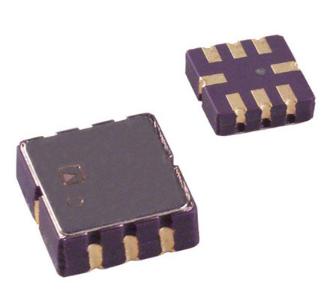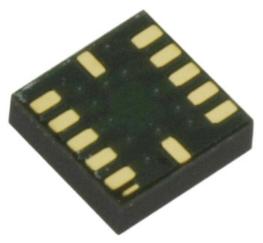Advances in Accelerometers Broaden User Choices
資料提供者:Electronic Products
2011-10-06
There are a number of factors that have led to rapid advances in accelerometer technology. First and foremost is the expanding market for such devices, particularly in automotive, consumer, and medical electronics, where accelerometers enable new features that help products succeed in the market. For example, automatic collision notification (ACN) systems, motion-sensitive game controllers and smartphones, and inertial footpods for measuring running performance all owe their existence to a new breed of highly compact accelerometers.
From a technical perspective, it is the maturing of micro-electromechanical systems (MEMS) technology that has led to the widespread availability of reliable devices in smaller and smaller packages from an ever-increasing number of MEMS foundries. Further, MEMS designs have benefitted from the incorporation of digital electronics to not only improve their performance but also simplify their integration into the final systems. The availability of such devices is giving rise to a new generation of environmentally aware electronic systems and, at the same time, giving rise to better products serving traditional functions in industrial applications.
Single-axis accelerometers
Accelerometers are available today that can measure acceleration in one axis (x, y, or z) only, or in two or three axes simultaneously. An excellent example of a precision single-axis accelerometer designed for automotive control applications is the SCA620-CF8H1A from VTI technology (Figure 1). Based on the company’s capacitive 3D-MEMS technology, it is intended for use as a z-axis sensor and is designed for high reliability, accuracy, and stability over temperature and time, for precise measurement of acceleration, inclination, motion, or vibration. The AEC Q-100-qualified device has a measurement range of ± 1.7 g with 1.2 V/g sensitivity, provides an analog (0 to 5 V) output that is ratio-metric (that is, the output value depends on the value of the input supply voltage), and can withstand shocks to 20,000 g.

Analog Devices also offers a single-axis accelerometer —the ADXL78 high-g iMEMS accelerometer (Figure 2)—with a ratio-metric output, but with a much wider measurement range. Originally designed for use in front and side impact airbags, it can also provide a complete, cost-effective solution in a variety of other applications. Available in ± 35, ±50, and ±50 g ranges, the device has a self-test feature that exercises all its mechanical and electrical elements with a digital signal applied to a single pin, so users can verify device operation to highly reliable performance as well as preventive maintenance. Operating with a 5-V source input (VDD), output sensitivity for the ± 35 g version is typically 55 mV/g.

Dual-axis devices
Freescale Semiconductor recently introduced the MMA6331L two-axis (x, y) capacitive micro-machined accelerometer (Figure 3), a MEMS sensor aimed at handheld, battery-powered electronics. In addition to built-in signal conditioning, a 1-pole low pass filter, and temperature compensation, the low-power devices has a feature called g-Select that lets users choose either of two ranges — ± 4 g and ± 9 g — at any time during the operation of the device by sending a logic 0 or 1 to a dedicated g-Select pin.
The typical sensitivities of the MMA6331L‘s ratio-metric output are 308 mV/g in the ± 4 g range and 83.6 mV/g in the ± 9 g range. The device is designed to work from a 2.2 to 3.6 V supply, typically drawing just 400 µA in normal operation, while in sleep mode, current drops to a mere 3 µA, significantly reducing battery drain.

STMicroelectronics also offers a dual-axis MEMS accelerometer — the LIS244ALH — with two user- selectable ranges: ± 2 g and ±6 g. It is capable of measuring accelerations at high frequencies — up tp 2.0 kHz on all axes. Like the ADXL78, the 4 x 4 x 1.5 LGA packaged device has built-in self-test capability.
Three-axis sensors
Three-axis devices are receiving a great deal of attention these days because they provide all types of acceleration information, thereby supporting an extremely broad range of applications in a single package. One of the first companies to develop commercial MEMS technology, Bosch Sensortec introduced its BMA120 digital triaxial acceleration sensor (Figure 4) as “a new generation of digital acceleration sensors.” The BMA120 integrates several features that facilitate its use in such motion detection applications as device orientation detection, gaming, HMI, and menu-browser control, among others.

Unlike the sensors previously discussed, the BMA120 outputs its measurements and can be controlled through a serial digital interface — either SPI or I²C — which simplifies integration while reducing parts count. The accelerometer, which has built-in self-test, provides four user selectable ranges — ±2, ±4, ±8, and ±16 g — with sensitivities ranging from 16 LSB/g to 2 LSB/g depending on range. The sensor also lets users set the device for different bandwidths: 50, 75, 150, 250, and 600 Hz as well as 1 kHz. And the unit is an extremely low-power device; it operates from a 1.8 V supply and draws 430 µA in operation and a tiny 2 µA in sleep mode. Demand for triaxial sensing is high, and many of the suppliers previously mentioned are also offering triaxial sensors to compete with Bosch’s. The obvious winner in this case is the user.
Summary
Recent developments in MEMS accelerometers has led to new applications in automotive, consumer and medical electronics markets. This article has explored single-, dual-, and three-axis sensors, presenting device examples from major suppliers. More information can be obtained by using the links provided to pages on the DigiKey website.
聲明:各作者及/或論壇參與者於本網站所發表之意見、理念和觀點,概不反映 DigiKey 的意見、理念和觀點,亦非 DigiKey 的正式原則。







